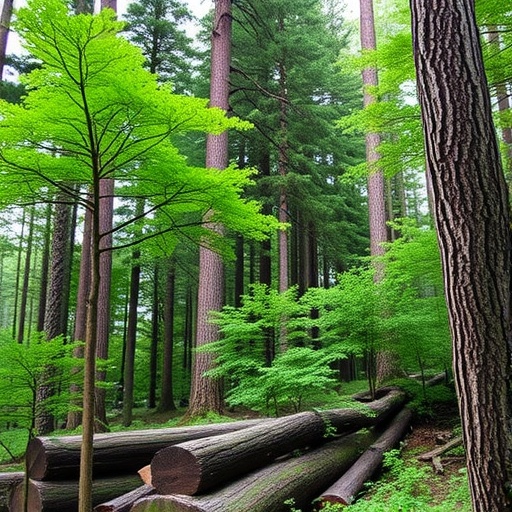Recent studies have illuminated a significant relationship between forest resilience and structural diversity, highlighting the pressing need to comprehend this intricate interplay amidst growing environmental challenges. The research spearheaded by scientists seeks to untangle the complexities surrounding forest dynamics, focusing specifically on how variations in forest structure, dubbed Functional Structural Diversity (FSD), can influence the resilience of these ecosystems to disturbances. Such disturbances, often amplified by climate change, threaten to undermine the very foundations upon which forest health and biodiversity depend.
Understanding the factors that contribute to forest resilience is paramount in an era where ecological stability is increasingly compromised. The current research employs advanced analytical techniques, primarily the Individual Conditional Expectation (ICE) method, to predict how local environmental conditions affect the resilience of forest ecosystems. This method allows for the extraction of local partial dependencies at each pixel within the study area, thereby providing insights into how specific elements of ecological diversity and structure correlate with the restoration rates of forests following disturbances.
The findings reveal a predominantly positive relationship between resilience, gauged through AC1-derived metrics, and the combined horizontal and vertical structural diversity, termed FSDH+V. Remarkably, this relationship is evident in a staggering 80% of the forested areas investigated. These results not only underscore the critical role that structural diversity plays in promoting forest resilience but also suggest that enhancing biodiversity could fruitfully contribute to forest recovery processes after significant perturbations.
Digging deeper into the data, it’s evident that the relationship becomes less pronounced when contrasting horizontal diversity (FSDH) and vertical diversity (FSDV) are assessed separately. Pixels mapped for these alternative metrics displayed positive relationships with resilience in 73% and 70% of forest areas, respectively. Nevertheless, the magnitude of these associations appears diminished compared to the combined metric, indicating that while horizontal and vertical diversities positively impact resilience, their collective influence yields a more robust connection to the ecological processes at play.
Geographically, the strongest positive responses were observed in central Europe, characterized by high FSD levels. This pattern suggests that not only does structural diversity bolster resilience, but it can also serve as a critical buffer against environmental stressors, amplifying the forest’s capability to rebound from disturbances. Nevertheless, it is crucial to recognize the uncertainty inherent in applying globally derived models to specific locales. The analysis indicated that the majority of forest areas exhibited only modest positive relationships, hinting at the variability that can exist across different environments and their unique ecological contexts.
Interestingly, some regions, particularly in Northern France, presented instances of inverse relationships, though these appeared weak and could be attributed to statistical anomalies rather than substantive ecological insights. Such disparities highlight the complex nature of forest dynamics and the potential pitfalls of generalizing findings across diverse forest ecosystems. It also stresses the need for localized studies that account for specific biogeographical and ecological variations which may influence resilience.
The ramifications of this research extend beyond academic inquiry; they carry significant implications for forest management practices and conservation strategies. Enhancing structural diversity within forest ecosystems emerges not merely as a theoretical proposition but as a tangible strategy for fostering resilience against climate-driven declines. By proactively managing forests to improve their structural diversity, conservationists and land managers can potentially catalyze a positive feedback loop whereby increased biodiversity directly contributes to enhanced ecological stability and recovery rates.
Moreover, as we navigate the challenges of a rapidly changing climate, understanding how different forest configurations impact ecosystem dynamics becomes increasingly urgent. The integration of such insights into broader conservation frameworks may pave the way for innovative approaches to ecosystem management that prioritize resilience and adaptability. In essence, by appreciating the benefits of diverse forest structures, stakeholders can better equip forests to withstand and recover from the multifaceted impacts of climate change.
This highlights a pivotal research avenue that calls for collaboration among ecologists, forest managers, and policymakers. By fostering partnerships that bridge scientific findings and on-the-ground practices, we can translate these insights into actionable strategies that bolster the health and resilience of forest ecosystems. Investing in continuous research and observation will allow for the adaptation of management strategies in real-time, ensuring they remain effective against a backdrop of ongoing ecological shifts.
The use of advanced analytical methodologies and the emphasis on pixel-level analysis signify a paradigm shift in how we approach forest resilience studies, offering a granular perspective that was previously hard to achieve. This approach not only enriches our understanding but also enhances the precision with which we can evaluate the health of forest ecosystems. As we look to the future, these insights may facilitate the development of targeted interventions that maximize resilience across varied forest landscapes, ultimately safeguarding biodiversity for generations to come.
In conclusion, the interplay between forest resilience and structural diversity represents a frontier ripe for exploration. As we seek solutions to elevate forest resilience in an era of unprecedented ecological change, embracing research findings while tailoring them to local contexts will be essential for advancing our conservation objectives. The efforts to understand and enhance these relationships stand to profoundly impact our ability to maintain healthy forests capable of thriving under the pressures of climate change and human activity.
Working together, scientists, conservationists, and policymakers can harness the power of structural diversity to create more resilient forests, sustaining the vast ecosystems upon which countless species, including humans, rely. As the evidence mounts, the imperative to act becomes clearer, highlighting the crucial role of forests in our global ecological landscape and the urgency of preserving their resilience for future prosperity.
Subject of Research: The relationship between forest resilience and structural diversity.
Article Title: Enhanced structural diversity increases European forest resilience and potentially compensates for climate-driven declines.
Article References:
Pickering, M., Elia, A., Oton, G. et al. Enhanced structural diversity increases European forest resilience and potentially compensates for climate-driven declines. Commun Earth Environ 6, 852 (2025). https://doi.org/10.1038/s43247-025-02592-8
Image Credits: AI Generated
DOI: 10.1038/s43247-025-02592-8
Keywords: forest resilience, structural diversity, climate change, ecological stability, biodiversity, conservation strategies, forest management, environmental stressors, ecosystem dynamics, research analysis.




